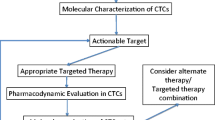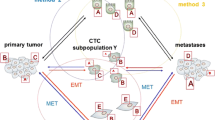Abstract
Breast cancer is the most common type of cancer among women, and clinicians have long recognized its heterogeneity. Its detection and treatment in early stages allow for reduction of mortality. Despite the advances and new strategies for combining surgical, radiotherapy, and chemotherapy options, however, the percentage of patients developing metastases and advanced stages remains high. Even though serum tumor markers have been used for the early diagnosis of metastases, their systematic determination has not had an effect on survival. Methods that are more reliable are needed to detect metastases earlier than with the common clinical methods and thus start treatment before overt relapse. Early indicators of response or resistance to treatment are also an issue in clinical practice. Imaging techniques are time consuming, and it is difficult to detect changes that indicate response limited to therapy, and approaches to defining changes in tumor mass are time and resource consuming.
In contrast, detection of circulating tumor cells (CTC) could be a useful tool in early detection of relapse and response to systemic chemotherapy. Extremely sensitive techniques are available that are easily applied to peripheral blood samples, which might provide enormous research possibilities in this area.
Similar content being viewed by others
References
Greenberg PA, Hortobagyi GN, Smith TL et al (1996) Long-term follow-up of patients with complete remission following combination chemotherapy for metastatic breast cancer. J Clin Oncol 14: 2197–2205
Pierga JY, Bonneton Ch, Vincent-Slamon A et al (2004) Clinical significance of immunocytochemical detection of tumor cells using digital microscopy in peripheral blood and bone marrow of breast cancer patients. Clin Can Res 10:1392–1400
Braun S, Pantel K, Müller P et al (2000) Cytokeratin-positive cells in the bone marrow and survival of patients with stage I, II, or III breast cancer patients. N Engl J Med 342:525–534
Braun S, Voglt F, Naume B et al (2005) A pooled analyses of Bone Marrow micrometastases in breast cancer. N Engl J Med 353:793–802
Borgen E, Naume B, Nesland JM et al (1999) Standardization of the immunocytochemical detection of cancer cells in BM and blood: I. establishment of objective criteria for the evaluation of immunostained cells. The European ISHAGE Working Group for Standardization of Tumor Cell Detection. Cytotherapy 1:377–388
Kagan M, Howard D, Bendele T et al (2002) A sample preparation and analysis system for identification of circulating tumor cells. J Clin Ligand Assay 25:104–110
Kagan M, Howard D, Bendele T et al (2002) Circulating tumor cells as cancer markers. In: Diamandis EP, Fritsche HA, Lilja H et al (eds) Tumor markers: physiology, pathobiology, technology, and clinical applications. Washington, D.C. AACC Press pp 495–498
Allard WJ, Matera J, Miller MC et al (2004) Tumor cells circulate in the peripheral blood of all major carcinomas but not in healthy subjects or patients with non-malignant diseases. Clin Cancer Res 10:6897–6904
Stopeck A., Cristofanilli M, Budd T et al (2006) Circulating tumor cells — not serum tumor markers — predict survival in metastatic breast cancer. Proc Am Soc Clin Oncol Abst 9516
Pachmann K, Heiss P, Demel U, Tilz G (2001) Detection and quantification of small numbers of circulating tumour cells in peripheral blood using laser scanning cytometer (LSC). Clin Chem Lab Med 39(9):811–817
Pachmann K, Clement JH, Schneider CP et al (2005) Standardized quantification of circulating peripheral tumor cells from lung and breast cancer. Clin Chem Lab Med 43(6):617–627
Naito H, Kuzumaki N, Uchino J et al (1991) Detection of tyrosine hydroxylase mRNA and minimal neuroblastoma cells by the reverse transcription-polymerase chain reaction. Eur J Cancer 27: 762–765
Wood DP Jr, Banks ER, Humphreys S, et al (1994) Sensitivity of immunohistochemistry and polymerase chain reaction in detecting prostate cancer cells in bone marrow. J Histochem Cytochem 42:505–511
Sabbatini R, Federico M, Morselli M et al (2000) Detection of circulating tumor cells by reverse transcriptase polymerase chain reaction of maspin in patients with breast cancer undergoing conventional-dose chemotherapy. J Clin Oncol 14:1914–1920
Smith BM, Slade MJ, English J et al (2000) Response of circulating tumor cells to systemic therapy in patients with metastatic breast cancer: comparison of quantitative polymerase chain reaction and immunocytochemical techniques. J Clin Oncol 18:1432–1439
Umetani N, Giuliano LE, Hiramatsu SH et al (2006) Prediction of breast tumor progression by integrity of free-circulating DNA in serum. J Clin Oncol 24: 4270–4276
Lander ES, Linton LM, Birren B et al (2001) Initial sequencing and analysis of the human genome. Nature 409:860–921
Smirnov DA, Zweitig DR, Foulk OPW et al (2005) Global gene expression profiling of circulating tumor cells. Cancer Res 65:4993–4997
Smerage JB, Hayes DF, Doyle GV et al (2006) Assessment of circulating tumor cells in breast cancer patients undergoing neoadjuvant chemotherapy. Proc Am Soc Clin Oncol Abst 10079
Pierga JY, Mathiot C, Extra JM et al (2006). Circulating tumor cells (CTCs) detection in a randomized phase II trial of neoadjuvant chemotherapy for large operable and locally advanced breast cancer (REMAGUS 02): Preliminary results. Proc Am Soc Clin Oncol Abstr 10637
Camara O, Rengesberger M, Egbe A et al (2007). The relevance of circulating epithelial tumor cells (CETC) for therapy monitoring during neoadjuvant (primary systemic) chemotherapy in breast cancer. Ann Oncol 18:1484–1492
Müller V, Stahmann N, Riethdorf S et al (2005) Circulating tumor cells in breast cancer: correlation to bone marrow micrometastases, heterogeneous response to systemic therapy and low proliferative activity. 11:3678–3685
Pachmann K, Camara O, Lobodasch K et al (2006) Circulating tumor cells, tools for monitoring and targets for therapy. J Clin Oncol 24(18S): 32
Pachmann K, Camara O, Kavallaris A et al (2008) Monitoring the response of circulating epithelial tumor cells (CETC) to adjuvant chemotherapy in breast cancer allows detection of patients at risk of early relapse. J Clin Oncol 26(8):1208–1215
Xenidis N, Mavroudis D, Apostolaki S et al (2006) Effect of adjuvant treatment on the circulating ck-19 mRNA-positive tumor cells in patients with early breast cancer. Proc Am Soc Clin Oncol Abstr 20012
Lobodasch K, Fröhlich F, Rengsberger M et al (2007) Quantification of circulating tumour cells for the monitoring of adjuvant therapy in breast cancer: an increase in cell number at completion of therapy is a predictor of early relapse. Breast 6: 211–218
Meng S, Tripathy D, Eugene P et al (2004) Circulating tumor cells in patients with breast cancer dormancy. Clin Can Res 10:8152–8162
Pachmann CCR, Pachmann K (2005) Longtime recirculating tumor cells in breast cancer patients. Clin Can Res 11:5657–5658
Cristofanilli M, Budd Th, Ellis MJ et al (2004) Circulating tumor cells, disease progression, and survival in metastatic breast cancer. N Engl J Med 351:781–791
Cistofanilli M, Hayes D, Budd Th et al (2005) Circulating tumor cells: a novel prognostic factor for newly diagnosed metastatic breast cancer. J Clin Oncol 23:1420–1430
Budd Th, Cristofanilli M, Ellis MJ et al (2006) Circulating tumor cells versus imaging, predicting overall survival in metastatic breast cancer. Clin Can Res 12:6403, 6409
Cristofanilli M, Guarneri V, Valero V et al (2006) Circulating tumour cells (CTC’s) in metastatic breast cancer: Biological value beyond tumour burden. Proc Am Soc Clin Oncol (Abstr) 615
Meng S, Tripathy D, Shete S et al (2004) HER-2 gene amplification can be acquired as breast cancer progresses. Proc Natl Acad Sci 101:9393–9398
Datta YH, Adams PT, Drobyski WR et al (1994) Sensitive detectionof occult breast cancer by reverse-transcriptase polymerase chain reaction. J Clin Oncol 12:475–482
Zippelius A, Kufer P, Honold G et al (1997) Limitations of reverse transcriptase polymerase chain reaction analysis for detection of micrometastatic epithelial cancer cells in bone marrow. J Clin Oncol 15:2701–2708
Harris L, Fritsche H, Mennel R (2007) American Society of Clinical Oncology. Update of recommendations for the use of tumor markers in breast cancer. J Clin Onc 5287–5312
Author information
Authors and Affiliations
Corresponding author
Rights and permissions
About this article
Cite this article
Gasent Blesa, J.M., Candel, V.A., González, E.E. et al. Circulating tumor cells in breast cancer: methodology and clinical repercussions. Clin Transl Oncol 10, 399–406 (2008). https://doi.org/10.1007/s12094-008-0222-9
Received:
Accepted:
Published:
Issue Date:
DOI: https://doi.org/10.1007/s12094-008-0222-9




